For additional information relating to this article, please contact:
September 28, 2022NOVA SCOTIA ANNUAL POPULATION ESTIMATES AS OF JULY 1, 2022 As of July 1, 2022, Nova Scotia's population is estimated to be 1,019,725, an increase of 28,608 (+2.89%) over the revised July 1, 2021 estimate (991,117). In absolute and percentage terms, Nova Scotia's population grew faster last year than in any modern data series.
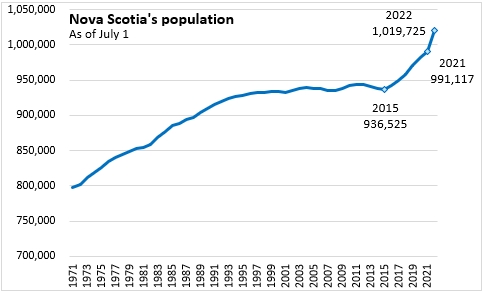
Note: population estimates for July 1 and components of population change in the 12 months up to July 1 are conventionally referred to as 'annual' population estimates.
National population growth was 1.84% from July 1, 2021 to July 1, 2022 - a record pace of growth. The fastest growth was observed in the Maritimes - led by Prince Edward Island. Growth was positive in all provinces, though slower in Newfoundland and Labrador as well as Quebec. The national pace of growth returned after slowing substantially in the previous year, during which COVID restrictions limited international population movements.
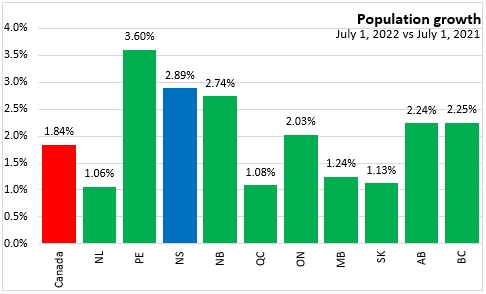
Last year's population increase of 28,608 was by far largest annual population growth in the modern data series (that started in 1971) as well as in historical records starting in 1951 and 1926.
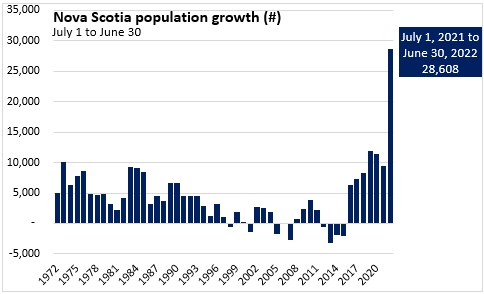
In percentage terms, Nova Scotia's growth of 2.89% was over one percentage point faster than the next fastest growth in the modern data series (1973).
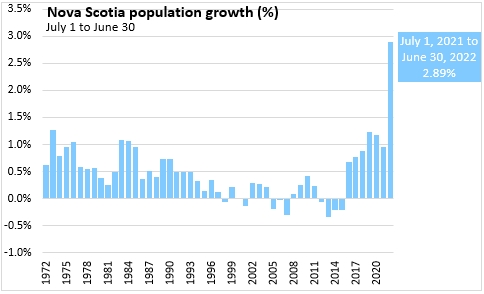
Nova Scotia's extraordinary population growth was attributable to a sharp increase in immigration (13,816) as well as interprovincial in-migration (27,640). There were more interprovincial out-migrants than in the previous year (13,561) but net interprovincial migration was a strong contributor to population growth. There were a small number of emigrants leaving Nova Scotia for another country (313) while net change in non-permanent residents (such as students and temporary foreign workers) added 3,816 to the population. Although the pace of births increased to 7,990 this was offset by a rising number of deaths (10,780).
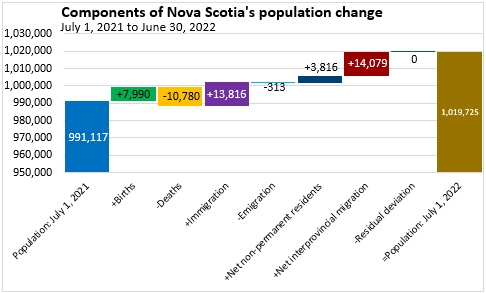
Natural population change (births less deaths) put continued downward pressure on Nova Scotia's population. From July 1, 2021 to July 1, 2022 there were 7,990 births and 10,780 deaths, resulting in a net natural population change of -2,790 over this period.

From July 1, 2021 to July 1, 2022, Nova Scotia reported 13,816 immigrants coming to the province. This was by far the highest level of immigration in records that started after the Second World War.
Net emigration was 313 persons moving from the province to another country between July 1, 2021 and July 1, 2022. The change in non-permanent residents (which includes students and temporary foreign workers) was a gain of 3,816 persons, rebounding after a decline last year. Accounting for the decline in net emigration and net non-permanent residents, the net international population change for Nova Scotia was 17,319 over the last year.
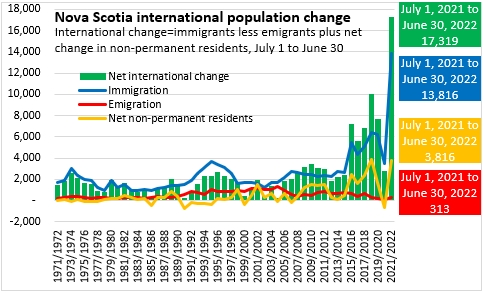
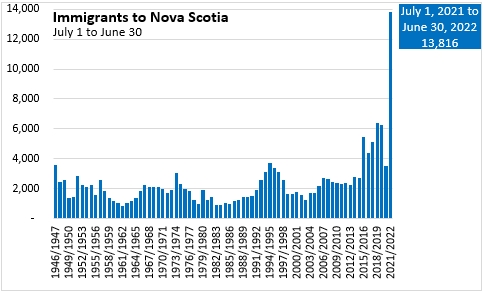
The period from July 1, 2021 to July 1, 2022 marked the seventh consecutive year of positive net interprovincial migration to Nova Scotia. The net increase of 14,079 in interprovincial movers is the largest amount back to 1961/1962. The number of in-migrants to Nova Scotia from other provinces rose to 27,640 while the number of out-migrants from Nova Scotia was increased by a smaller amount to 13,561. There were over twice as many in-migrants as there were out-migrants.
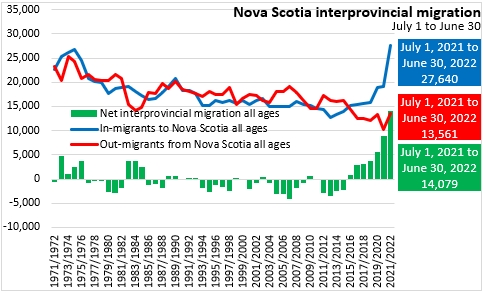
There was net positive interprovincial migration across the age distribution. Net interprovincial migration of children (aged 0-14) contributed 1,400 to Nova Scotia's population from July 1, 2021 to July 1, 2022 as in-migration of 3,379 was much larger than out-migration of 1,979.
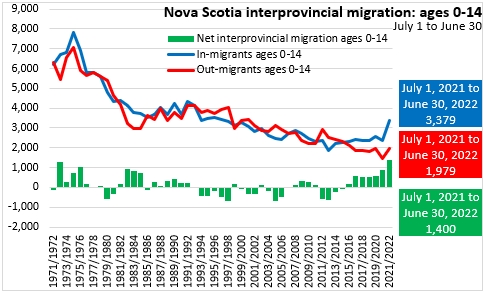
Youth interprovincial migration (ages 15-34) was positive at +7,503 over this period on a very sharp increase of in-migration to 14,040 while out-migration grew to 6,537. Youth in these age cohorts are notably more mobile than other age cohorts.
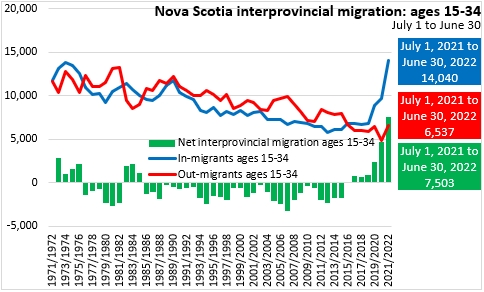
Net migration of those aged 35-49 was also positive at +2,164 on a rise in in-migration to 4,869 while out-migration grew to 2,705.
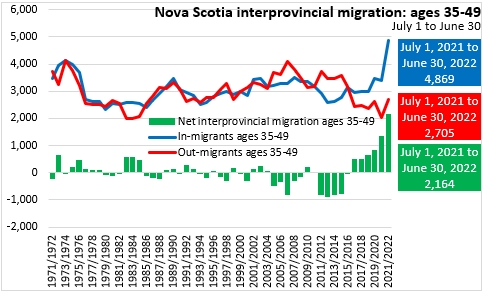
The pace of net migration among aged 50-64 accelerated to 2,066 on higher in-migration (3,509) while out-migration grew to just 1,443.
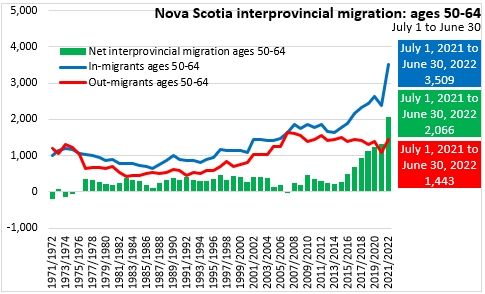
There have been substantial increases in in-migration of seniors aged 65 and older - rising to 1,843 while out-migration was less than half this amount (897), leaving a net interprovincial migration of 946 in this age cohort.

By source and destination, the largest sources of net interprovincial migration to Nova Scotia were Ontario (+11,234), Alberta (+1,178) and British Columbia (+882). There was a sharp rise in in-migration from Ontario - rising to 15,862 while only 4,628 Nova Scotians moved in the opposite direction.
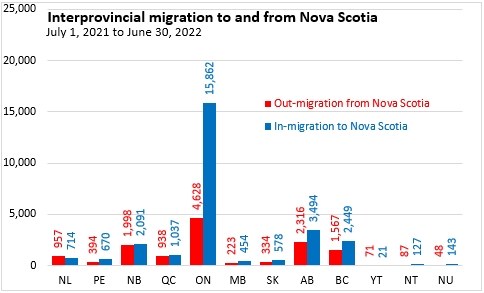
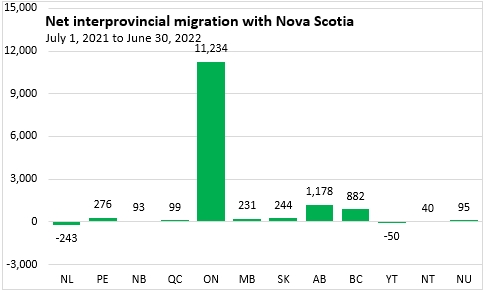

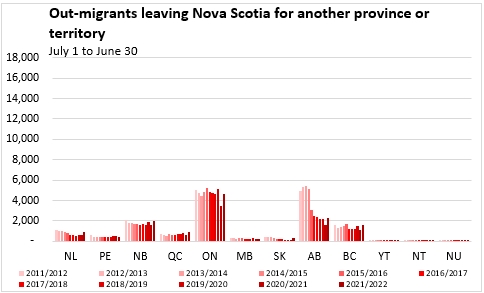

With significant increases in immigration and interprovincial in-migration of younger cohorts, Nova Scotia's median age contracted substantially - falling from 44.9 years as of July 1, 2021 to 44.2 years as of July 1, 2022. This was still the third highest median age among provinces after Newfoundland and Labrador and New Brunswick. The national median age was 41.0 years with the lowest median age in Manitoba (37.7 years).
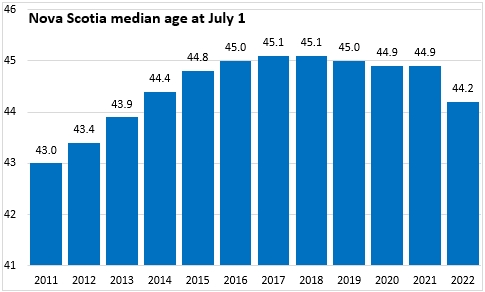
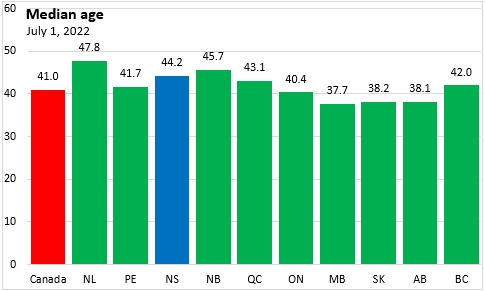
Immigration and net interprovincial migration have contributed to a reversal in declining populations of Nova Scotia's younger cohorts, particularly for those aged 15-34 and 35-49.
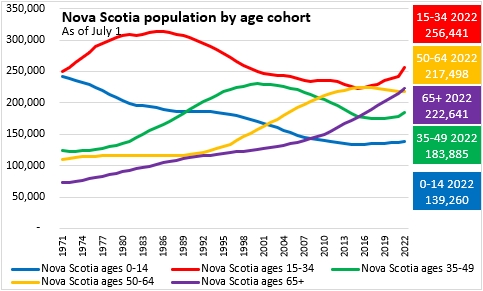
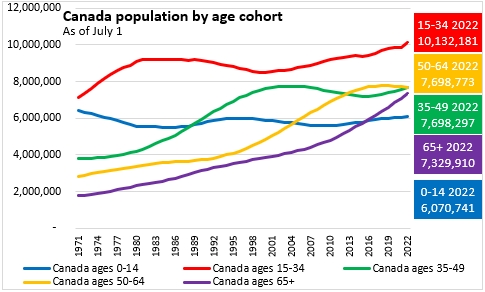
Despite a revival of growth among younger population cohorts in Nova Scotia, the population pyramid shows an older population than the national age distribution.
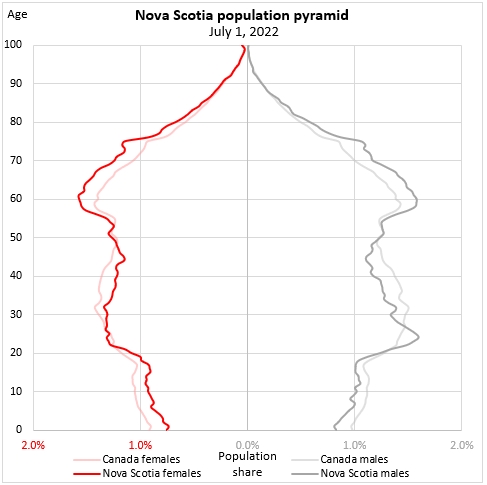
Source: Statistics Canada. Table 17-10-0005-01 Population estimates on July 1st, by age and sex, Table 17-10-0008-01 Estimates of the components of demographic growth, annual, Table 17-10-0014-01 Estimates of the components of international migration, by age and sex, annual, Table 17-10-0015-01 Estimates of the components of interprovincial migration, by age and sex, annual, Table 17-10-0022-01 Estimates of interprovincial migrants by province or territory of origin and destination, annual, Table 17-10-0009-01 Population estimates, quarterly, Table 17-10-0040-01 Estimates of the components of international migration, quarterly, Table 17-10-0020-01 Estimates of the components of interprovincial migration, quarterly